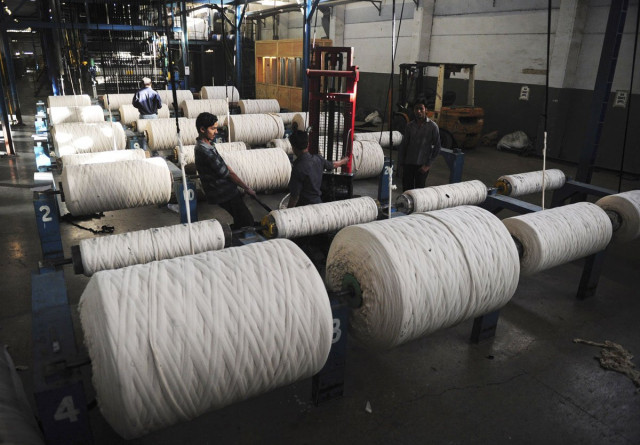Outlook: Stitching optimism for the textile sector
Industry players term package a surety for increasing exports.

File photo of textile factory. PHOTO: AFP/FILE
The textile industry – that contributes over 50% in country’s exports – is jubilant on the textile package the government announced in budget 2014-15.
The package includes both short-term and long-term concessional loans, duty-free import of machinery and incentives on technology upgrade.
Most of the incentives announced are related to the value-added textile sector. This depicts the government’s keen interest in increasing the country’s exports of finished textile products.
“The textile package will definitely boost output,” said Fawad Anwar, managing director at Al Karam Textiles Mills —one of the country’s leading composite textile mills.

Finance Minister Ishaq Dar also announced that textile industry units in the value-added sector would be provided Long Term Financing Facility (LTFF) for technology innovation from the State Bank of Pakistan (SBP) at the rate of 9% for 3-10 years duration.
He also announced that the mark-up rate for Export Refinance Scheme of SBP is being reduced from 9.4% to 7.5% from July 1, 2014.
Former Sindh Board of Investment (SBI) chairman Muhammad Zubair Motiwala, a renowned textile exporter, also hailed the textile package.
“This will definitely change the landscape of the industry especially of the finished products,” he said.
The textile sector was already enjoying duty-free import of machinery under textile policy 2009-14 but its duration was about to end on June 30, 2014. “In view of the need to take full advantage of GSP Plus facility in the European Union (EU), this concession would be allowed for another two years,” the finance minister announced.
Dar also announced that in future, all admissible refund claims of exporters will be disposed of within three months, if not earlier. In recent months, sales tax refund is one of the biggest concerns of textile exporters that has adversely effected cash flows.
Gigi industries Director Idrees Gigi said the incentives given to the textile industry are encouraging.
However, Gigi said that there is one concern for the garment sector, citing the increase in the minimum wage by Rs2,000 in this budget. This will hurt the garment sector’s profitability as it is a labour-intensive industry.
Pakistan is the fourth largest cotton producing country in the world but it failed miserably in converting its local produce into value-added products. It fetches only $1.17 billion per million bales whereas its nearest competitor Bangladesh gets $6.17 billion, China $7.09 billion, South Korea $10.68 billion.
Even if Pakistan sells half of its total cotton crop of 13.4 million bales at Bangladesh’s rate, it can earn $40 billion every year.
However, the country has lagged behind in value addition especially in the production of garments that does 731% value addition compared to 400% value addition of bed wears, 300% of processed fabrics, 230% weaving and 143% of towels.
Published in The Express Tribune, June 4th, 2014.
Like Business on Facebook, follow @TribuneBiz on Twitter to stay informed and join in the conversation.



















COMMENTS
Comments are moderated and generally will be posted if they are on-topic and not abusive.
For more information, please see our Comments FAQ